Richard Lyders and Joanna Smith with Connor Walsh and Shu Kinouchi in Red House.
Photo by Jeromy Barber.
Since we (Nancy Wozny & Tarra Gaines) have an ongoing conversation on what defines an immersive performance, we decided to share some of our adventures and to make some of our endless road trip banter public.

Photo by Karen Almond.
HAIR
Dallas Theater Center
We are trying to make the experience as immersive as possible — a fully authentic feeling of what it could’ve been like to have been in a warehouse or a park in the Summer of Love with music at the center of the room and young people exploring the possibility of a world with no limits and with peace and harmony as principles.
-Kevin Moriarty, Artistic Director of Dallas Theater Center
Nancy Wozny: We missed a great opportunity on our way to Hair to sell the back seats of your Prius as sort of a hybrid performance in a Hybrid, “N & T Talk rash on the Way to Dallas.” Immersive theater on wheels! Cool environment, check; audience agency (bathroom breaks), check; great theater in our conversation, check. Boom! We are in! So, was Hair immersive?
Tarra Gaines: Before I get to the Hair question, I’d like to point out that Catastrophic Theatre’s Tamarie Cooper beat us to immersive theater on the road about 17 years ago when she did one of her annual summer shows on a school bus.
NW: Ha! Tamarie!
Our drives to Dallas are often dramatic, remember our “Mike Daisey on Ice” weekend, or how about when all the street signs were warning us not to drown?
TG: Moving on (pun intended), one thing I think is strange about immersive theater conversations is that they tend to either begin or end with the question of whether some show qualifies to enter the category. But I find your favorite counter question—Is this immersive experience actually theater?—to be just as valid and important.
NW: I read this as “vapid” not valid. My son recently told me that the question “Is this theater?” is a stupid one. I know, I should get over this. Back to Hair.
TG: Somehow this Dallas Theatre Center production of Hair was the first time I’ve seen a live version of the musical, and I found myself wondering if, for the last 50 years, people should have been asking the “Is it theater?” question of this rather plotless but now-classic musical. I imagine if I saw a traditional production, sitting in a generic, cushiony theater seat and watching the performance on a distant proscenium stage, I’d have a musical trippy experience, but think of it more as a 1960s themed concert more than theater.
NW: Because there’s no script, just great songs. And nudity is always fun.
TG: While the immersive police might write it off as a not-immersive-enough citation for the lack of audience agency in this DTC production, I found its immersive-lite qualities, being surrounded by dancing hippies and sitting on their era appropriate kitchen chairs, helped it pass the “Is it theater?” test for me.
NW: I loved the chairs. Everyone one of them, and when everyone took off their clothes, but mostly the chairs. And the knitted cozies on the trees in front of the Wyly Theatre, best theater foreplay ever! But let’s get to the idea of a show being all around us. You saw Natasha, Pierre & The Great Comet of 1812 on Broadway, it was one of those all around you shows. Does that count? Do we need to be actually moving?
TG: This all goes back to the “Is it immersive if butts stay in the seats?” question, doesn’t it? Personally, if the action surrounds me, which it did in Great Comet, and everyone, cast and audience, acknowledge each other while pretending we’re not in a theater in New York but somewhere else, in this case a Russian supper club, I’d still call it immersive.
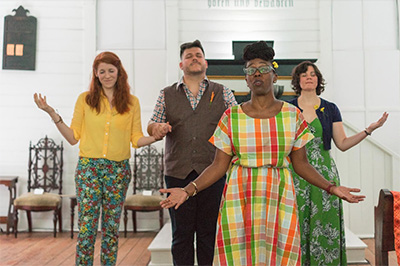
Church by Young Jean Lee
Horse Head Theatre
Horse Head seeks out plays and stories that have inherent “immersive” qualities. This was true even before immersive theater became an overtly popular trend in the American theatre landscape. Our founding mission statement and eight years of productions all have immersive elements, but are not what I would consider to be full-blown immersive theatre. We produce in site-specific locations; transform non-traditional spaces and places into new landscapes and settings; activate audiences by demolishing the fourth wall, encourage participation in pre-show rituals and activities; and generally try to avoid asking audiences to be passive observers. But the combination of immersive elements that we’ll use for a project is selected strategically. Storytelling, first and foremost, is what drives Horse Head projects.
-Jacey Little, Artistic Director, Horse Head Theatre
NW: Although Horse Head does not do the kind of wandering-around-within-a-space immersive theater, they were first with this type of all-around-you show in Houston when they launched with Red Light Winter, where they reconfigured Frenetic Theater to look like the red light district of Amsterdam. And didn’t we sit next to each other inside a whale for Moby-Dick? Before we get to Young Jean Lee’s Church, we have to consider the extremes Horse Head goes to in creating an environment.
TG: Horse Head was founded with the theater out in the wilds of the everyday world, yes. Even through changes in creative leadership they’ve managed to keep that ideal.
NW: There was something kind of nutty about placing that Young Jean Lee’s esoteric play in that stoic environment. It fit and didn’t. I like that about Horse Head.
TG: There does seem to be a trend in adding immersive elements to an already known work, going back to Hair as an example, but I see Horse Head’s Church production as the most extreme example of this, at least in Houston. They doubled the immersive possibilities first by staging it in a church, one of Houston’s oldest, and then by adding their own pre-Church immersive performance to explore Sam Houston Park. I don’t know that the actor-reverends guiding us around the park necessarily gave me further insight into Lee’s play, but it did add a historical element to the whole experience. On its own, Lee’s Church is such a wild religious, and surrealist ride, the immersive pre-show did help to ground Church to a Houston setting.
NW: They make nothing easy for themselves. Of all the Horse Head shows, which stood out as the strongest?
TG: I have great fondness for The Whale or Moby Dick and the completely bizarre premise that the whole audience has been swallowed by a whale in Galveston Bay, who then requires actor “Philip” to perform scenes from Moby Dick before the whale will deign to vomit the audience out. And then they built an air conditioned Geodome to become the whale. That’s some crazy, committed immersive theater right there.

Photo courtesy of Strange Bird Immersive.
Man From Beyond
Strange Bird Immersive
Immersive theatre isn’t something you see; it’s something you do. One of my favorite taglines for Strange Bird Immersive is “Don’t just see what happens. Be what happens.” This difference is what makes a generation who doesn’t see theatre suddenly buy tickets. Immersive theatre is to traditional theatre what a video game is to movies. Sometimes you’re tired and want to sit passively while a story gets told to you. But if you’re feeling a little more energetic, there are many ways to make the audience active, and documenting the wide-range of possible structures for activity is what Immersology is all about. Sometimes the audience exists to the performers; they may answer questions and form relationships with the characters. Or the audience can choose what they see. Or the audience may make a choice or perform an activity that alters the story.
-Haley Cooper, Co-founder, Strange Bird Immersive
NW: If only we could have included everything Strange Bird wrote in response to my question, “What is immersive theater?” They have most certainly thought this out. Anything to say on all they had to say?
TG: If anyone ever had the impression that immersive theater is loose, unplanned and predominantly improv, the Strange Bird artistic crew would certainly disprove the misconception. When they gave us a secret peek at their behind-the-scenes mapping of audience reaction scenarios, I couldn’t believe the detailed if/then plans that went into creating the show.
NW: Man From Beyond was totally immersive for sure, but I’m not sure on the theater part of it.
TG: Man From Beyond gets a pass as theater for me, but with the caveat that this type of production elevates the backstage elements and especially the stage managing role to a higher level of importance than the acting to creating a show.
NW: The backstage bells and whistles were terrific, and highly theatrical for sure. I am just so old fashioned, needing a script.
TG: If you need at least one actor on stage for a certain percent of time of a show, in front of or, in this case, amid the audience, (let’s say 50%) then it might not quantify as theater.
NW: I prefer words written by a playwright, preferably Stoppard or Pinter, in a pinch I will take Will Eno or Annie Baker.
The audience is an iffy playwright. It’s not to say that the gang of theater writers who shared the Strange Bird experience with us (Jessica Goldman and Trevor Boffone) were not super fun conversationalists. Hell, my scream even made Goldman’s review! But it is funny to have it come down to percentages. The Strange Bird team is so rigorous, so passionate, and so completely dedicated to this world of theater, that’s it’s hard not cheer for them. Also Man from Beyond was an escape room. Funny thinking about theater as a place we have to escape from. I’ve always felt a sense of captivity in every theater seat.

Photo by Jeremy M. Lange Photography.
Now Now Oh Now
Rude Mechs
Of all of our plays, Now Now Oh Now probably best fits someone’s definition of immersive theatre. It is definitely the hardest we’ve ever asked the individual audience member to work – lots of walking around and some puzzle-solving… but we never drop wholly into any fiction, so it’s hard to make anything truly immersive, if that is the goal – to forget where you are? Is it? It has always been important to us to keep the audience active and engaged in the work – even if it is as small a gesture as yanking them out of the fiction occasionally to notice we are all in the room together.
-Lana Lesley, Co-Producing Artistic Director, Rude Mechs
NW: On the theme of escape rooms, we were more or less in one during in the first half of Rude Mechs Now Now Oh Now. In our discussions we kept returning to this experience. Why do you think?
TG: Experiencing more Texas immersive theater these last two years, I realize how successful I find the show depends a lot on balance, that fine balance between the immersive qualities, audience agency elements and theatrical aspects of a production. Now Now gets that balance almost perfect. The escape room/puzzle middle section of the work gives the audience an opportunity to join in on the play of the play but it never overwhelms the dramatic, scripted nature of the show as a whole.
It also contained that one so important element for the hippest of immersive theater shows, a few minutes dedicated for the audience to drink their shot of included-in-the-ticket-price alcohol.
NW: A delicious concoction of Tequila and grapefruit juice to be exact.
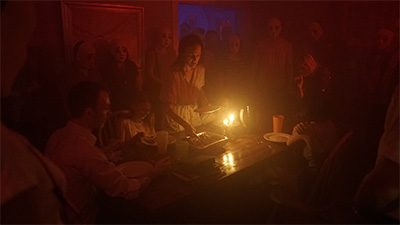
RED House
Dinolion
One way RED HOUSE stands out among current immersive work is that it could also be described as an elaborate Black Kite concert with strong narrative and interactive elements. It’s like the liner notes of the album mixed with the artist’s journals to create a world you can explore and experience.”
-Jeromy Barber, Co-owner of Dinolion
NW: I got freaked out when I was told to call someone at a precise time to get the location, that’s when I decided to send you instead. I am weak, unadventurous and slightly lazy. I don’t want to be in the show. I’ve been in a lot of shows already. You were in the show. And?
TG: With the stipulation that I’ve unfortunately not had a chance to see any of the performances/experiences from the immersive company out of Dallas, Dead White Zombies, I found Red House the immersivest (yes, I’m making up a word) of the shows I’ve seen in Texas. With a storyline based on the music of Vicki Lynn Tippit of the band Black Kite, the Dinolion creative crew turned a house into their stage and pretty much every spooky room becomes a set and landscape the audience can explore and investigate in this theatrical experience.
NW: A few months later I did see ruins of the Red House set and it seemed way cool, and then the dread set in that I had missed what seemed like a really awesome show. When we met with Barber I was so taken with how taken he is with this form of theater. He sees all these shows. That feels important, to see where this trend is heading.
TG: Wandering through the house and watching and occasionally interacting with the characters and dancers, I could see the Sleep No More influence on the work, so it was not a surprise when Jeromy Barber later told us he was influenced by the Punchdrunk creation that has become the standard for immersive theater in the U.S.
NW: So let’s get to the Sleep No More-ization of theater, where the audience is on the move, making choices, being called into pantries, having this thing called “agency.”
TG: And now for my musing on this whole agency criteria for immersive theater. When I wrote my survey of fourth wall-breaking/audience participation theater in Texas a year and a half ago, I referenced the Player King’s line from Stoppard’s Rosencrantz and Guildenstern Are Dead about the audience getting caught up in the action. I now wonder if sometimes a performance gives the audience so much agency that we can’t get caught up in the action of the story. Instead of finding a new perspective on the world or another human being by watching these characters within a story, do we instead become even more immersed in our own heads?
NW: This happened to me in Man from Beyond. I neglected to get caught up in the story.
TG: For me this happened with a tomato dilemma during Red House.
NW: It’s always a great when tomatoes enter a discussion on theater. Go on.
TG: While I wandered around the first floor and into the kitchen for some minutes during the performance, one of the spirits (dancers) in the piece came in, lined up those of us milling about and started distributing food from the counter. I was given one of those plastic green baskets of cherry tomatoes, which I dutifully held. Our spirit guide then led us upstairs to the ongoing narrative happening in the teen’s bedroom and pretty much abandoned us. Left standing around with a bunch of tomatoes while watching the next cycle in this haunting family saga, I became less involved with the story and characters and more and more obsessed with where to put the tomatoes. Should I offer one to the scary father? Should I leave them in the daughter’s room where it seemed every scrap of paper had purpose and layered meaning? Should I be a good housekeeper and put them back in the kitchen? At that point, I didn’t want agency in the experience. I wanted a nice stage manager to come and deal with the tomatoes, so I could get back to discovering more about the characters and story.
NW: Well now, I’m not sure that the Red House folks cared if you didn’t want agency. It has been thrust upon you, and knowing you, and your capacity to connect and penetrate the most mundane things, I am certain that your agency would been something really fun. With tomatoes.
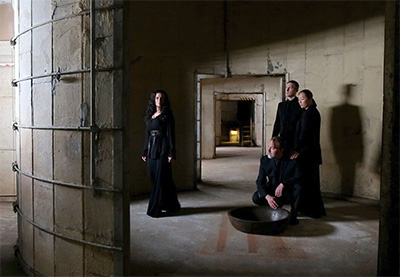
Misha Penton, soprano & director. Neil Ellis Orts, Michael Walsh, Sherry Cheng. Photo by D. Nickerson.
Misha Penton
Threshold at the Silos
Sound does amazing and unpredictable things in the cavernous, unique space of the Silos. It’s conducive to the creation of a new kind of world, physically and sonically because it’s disorienting and labyrinthine with mysterious and imposing aesthetics. I wanted to create an experience that felt like a place the audience had never been, that anything might happen, and that we were all witnesses and participants, simultaneously.
– Misha Penton, soprano and creator of Threshold
NW: Penton has a point. Sound can surround like nothing else. The most engaging moments of Threshold were aural, when I was just standing, away from the crowd, listening to the score, You?
TG: Threshold seemed different to me for our immersive survey in that, while the experience took the audience through the atmosphere of a story, sound and music were the main focus of the performance. In other works we’ve seen music as a vital component but never the main focus. Is Threshold a step along the way to immersive symphonies? I can already imagine some young (probably Brooklynite) composer requiring all audience members to wander through an old orchestra hall playing the triangle during a performance.
NW: I hope not. Let’s talk logistics for Threshold. Her people movers were a stern bunch. I pushed back about being told to move this way and that way. But honestly, you give people agency and they may not do as told. I left the group. Went rogue. Made my own experience. I did that “agency” thing.
TG: Thinking about it afterwards, I had to laugh that as experimental and intriguing as Threshold felt, Penton made sure to include one of the most standard but unsung and forgotten performing arts crew members, the ushers.
NW: Note to self: Force you to write a one-woman show about your time as an usher at the Alley.
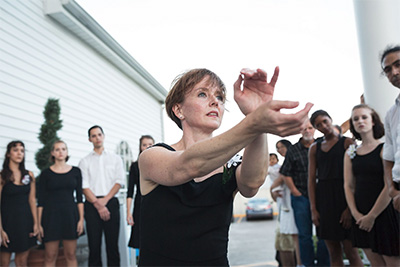
Jennifer Mabus
The Pilot Dance Project
Requiem
I have been inspired by Third Rail Projects’s work in New York, and for my research, I was able to experience two of their works: Then She Fell, a meditation on Alice in Wonderland set in a space modeled after a former psych ward, and a work in progress that they were researching in a historic home on Governor’s Island. These experiences impressed me with the impact of environment and interactivity combined with high level and humanistic dance performance. I left enlivened and contemplating deep things of the heart.
-Jennifer Mabus, independent choreographer
TG: Performed in the historic Morales Funeral Home, Jennifer Mabus’s Requiem wove in some true stories from Morales family history, but it also seemed to convey through the dances universal feelings of grief and mourning. The dancers surrounded the audience but also led them from room to room in the home. The second to the final section of the performance allowed individual audience members to wander and linger at any one dance in a room or move on to the next one, almost as if everyone involved, dancers and viewers, had become spirits or perhaps memories.
NW: Now, I didn’t see Requiem, but since when has that stopped me from thrusting opinions at things! But I will say that funerals, having recently co-planned my mother’s, are highly interactive and theatrical events. And I will also say that Mabus is hands down one of the strongest contemporary performers in Texas. So when she moves, I am moved by her. So there’s that. Stay tuned for more immersive events from her. She wrote her master’s thesis on immersive dance.
TG: Mabus brings up an important point about the connection between immersive dance and theater. They seem to influence each other and, in several shows I’ve experienced, become difficult to categorize between the two. But I do wonder if the agency question gets asked quite as much with an immersive event that contains more dance than theatrical play. Do the dancers have to give the audience the opportunity to join in on the dance or to wander around a space, or is having the dance surround you enough of an immersive experience?
NW: Great question and it will be addressed head on when we get to choreographer Annie Arnoult.

Annie Arnoult
Open Dance Project
‘Bout a Stranger
Immersive performance offers two great advantages for the modern day dance audience. Firstly, as choreographers, we are not handing meaning to an audience. The meaning making happens in the space between the performer and the audience member. Immersive performance situates the audience member physically in this “in between” space, helping them understand their place as meaning maker in a very real and tangible way. Secondly, the dance audience experience depends heavily on kinesthetic empathy – the audience member syncing up with the dance performer’s breath and movement in such a way that he/she feels each twist and turn the dancer’s body takes. Immersive performance allows for a more intimate kinesthetic connection. By virtue of proximity, audience members can hear the breath of the dancers and feel the impact of their footsteps on the stage floor.
-Annie Arnoult, Artistic Director, Open Dance Project
NW: I wish you had seen ’Bout a Stranger. It’s my immersivity winner. So, now we were not exactly part of the show, but, as the evening wore on, the audience, started to look, well, Woody Guthrie-ish. I think my brain had entered “Stage Immersivity” (yep, that’s a new brain state). So why did it work so well? There was such a grace to the evening. With the audience let loose in the beginning to explore. So now to answer your question, this period of pre-show exploring, which in retrospect was part of the show, was crucial in the entire experience. I rifled through Guthrie’s things! I found a check for $1.50. There was a touch of a grandma’s house, slightly musty, dusty, damp, old bookstore smell. We were well in this world before any dancer showed up. Did you get to do this in any of your immersive wanderings?
TG: Red House was all about exploration, opening drawers, rummaging through closets and wandering from room to room, with or without tomatoes. Requiem had one section of allowed wandering though no drawer opening opportunities. Earlier in the show, I was pulled up from my seat by Jennifer Mabus herself.
NW: That seems to be a thing. I had my bench pulled in ‘Bout a Stranger! Immersive theater folk do not like sitting. What happened next?
TG: With no words, only gestures, she asked me to mirror a few movements in her dance. I enjoyed that moment of possibility, becoming a part of the dance, but I also felt a bit self-conscious, though not embarrassed.
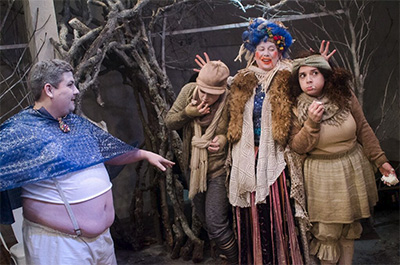
Hansel and Gretel
The Rec Room
I love playing with scale. When I stage a piece in a small, cramped space, I have more limitations that force me to get creative with the way I tell a story. I have the luxury of using finite details that shape the whole environment for the audience that are not able to be used in a traditional theater. I am interested in the whole environment influencing the audience’s experience. I like a sense of danger when I see a performance. Hansel and Gretel gave me the opportunity the bring the audience into the foggy winter woods. Walking into the room before the performance was a bit scary because it was unexpected from the very start. During the show I was able to use the woods as a cage or a womb that surrounded the audience and performers. It felt dangerous and oddly comforting at the same time, which I think was appropriate for the themes of Hansel and Gretel. In The Rite of Spring, I wanted to make the audience feel like they needed to fight for the performers. I wanted everyone to feel like equals and part of the movement, even though the audience was not performing or interacting with the dancers. I think that the word “immersive” in theatre has become a trigger word. Some people might think that they have to be part of the performance or interact with the performers. I just want the audience immersed in the story.
-Matt Hune, Artistic Director, The Rec Room
NW: Notice his choice of words. He wants the audiences immersed in the story, not part of the story. Hune is on to something here, that has less to do with agency and more to do with solid directing chops. And he has an airtight sense of scale. Hansel and Gretel upped the “in the action” component, putting us inches from his enchanting production. In Hansel, I could have easily taken a bite out of the sprinkle cake that descended from the ceiling nearly onto my lap. Do inches matter here?
TG: That surrounded by and immersed in the story concept might work better with someone like myself who tends to become overanalitical and perhaps indecisive when given too much agency in an immersive production. But moving on from the agency question, let’s consider immediacy. If the space is small enough does any performance become immersive merely by the fact that the performers might bump into you while dancing, singing or acting?
Both Hune-helmed shows felt dangerous in some ways because they were so close, though I never had a sense of personal threat. Hansel gave off an audacious fun vibe, especially with all the sand and flour flying throughout the performance. During Rite of Spring (choreographed by Laura Gutierrez), I felt like an allowed onlooker into some secret, well, ritual or rite. The dancers did occasionally engage the audience but no one was asked to join in the dance. There was one guy at the performance I saw, however, who had to jump out of the way more than once as a dancer hurtled towards him. Do you have a similar occurrence at your performance?
NW: Yes! My husband was that guy during the Rite show that I went to. It was as if we were sharing the space with the tribe as witnesses more than performers. Our big job was to get out of the way. That said, Hansel and Rite were the best shows of the year for me.
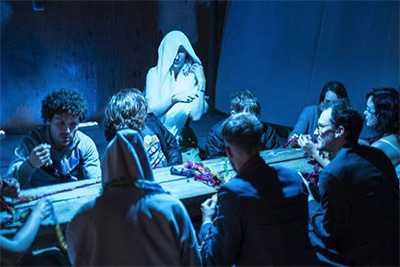
Photo by Alisa Eykillis.
Dead White Zombies
Thomas Riccio
An immersive performance is unique to a yearning, a moment in time and space, it is a bit of framed reality, a microcosm constructed from an ongoing macrocosm. We move through it with heightened awareness, walking through a forest of symbols, strengthened and aware of how our body thinks, moves, responds, aware of aliveness, glimpsing and feeling the deep structures that lay beneath reality, that which is often kept from us because of the world’s noisy clutter. Immersive performance is not theatre (a construct of conventions and rules), but rather it is a moment of individual liberation.
-Thomas Riccio, Artistic Director, Dead White Zombies
NW: “framed reality”
TG: I love this life-is-but-immersive-but-what-is-this-thing-you-call-theater, response from Riccio. I’ve never met Riccio, but in my head he has a French accent.
NW: I have. He does not. He’s from Cleveland. With his expertise in indigenous performance, ethnography, ritual, and shamanism he is coming at immersive theater from a different point of entry, and very far from the more commercial and gimmicky genres. But watching the video of Holy Bone, I realized how game the audience need to be. They can’t be a bunch of curmudgeons. The need to meet the piece half way and sometimes more. But I also appreciate that he is using real environments rather than a built set.
TG: Watching the video, I tried to imagine how I would handle some of the questions and weird interrogations the audience went through during their immersive journey. I have a feeling I would either panic or start giggling uncontrollably. Like many of the full-on immersive theatrical performances, I sometimes wonder how seriously the audience needs to commit to the experience.
NW: We all need to question this “theater” thing at least once a year. Final thoughts?
TG: I want to produce an improvised non-immersive play that would consist of an audience watching from a safe distance while I throw Riccio and the Strange Bird creative crew together in an escape room to watch them immersively fight.
NW: Fight? Can’t they just try to get out of that damn room? What else is in that room?
TG: Their immersive philosophy seem so different I think they might rumble a little, especially if I set the stage with the big hippy slide from Hair, lots of tomatoes and all the vodka from The Great Comet.
NW: OK. I’m in. And let’s get meta immersy and drive to Dallas with paying theatergoers in your back seat to see the next Dead White Zombies extravaganza.

